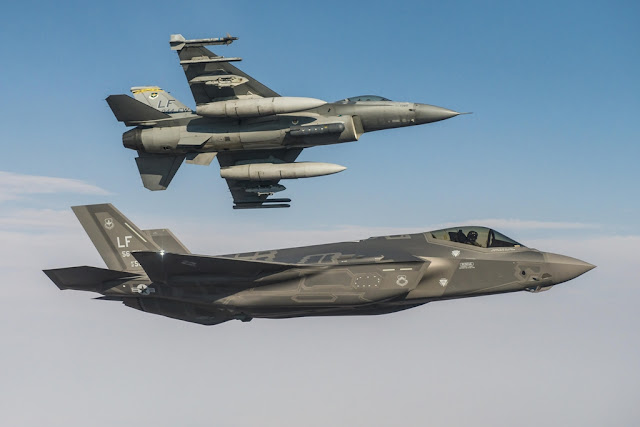F-35 BEGINS INTEGRATED TRAINING WITH F-16 AT LUKE AFB
In October, pilots of the 56th Fighter Wing began flying integrated direct support practice sorties in the F-35 Lightning II and the F-16 Fighting Falcon for the first time as a regular component of the training curriculum at Luke Air Force Base, Ariz.
The integrated training comes as part of the next step in the development of F-35 training and tactics, and helps pilots become efficient in conducting futuristic mission sets and aerial combat scenarios involving both fourth and fifth-generation fighter jets.
“The F-35 has reached a point where we can do both our continuation and upgrade training to a level where integration will benefit both fourth and fifth-generation pilots,” said Col. David Shoemaker, 56th Fighter Wing vice commander. “We are now flying dedicated sorties every day to train in F-16 and F-35 integrated direct support.”
The integrated training accomplishes two major training goals, first in exposing F-35 pilots to air-to-air combat scenarios against fourth-generation aircraft capable of mimicking adversaries that pilots would realistically face on today’s battlefields, and second in providing F-35 and F-16 pilots with experience in carrying out joint strike missions.
“The difference in the way of thinking between flying a fourth-generation and a fifth-generation fighter is tremendous,” Shoemaker said. “The ability to get out there and see the capabilities of the fifth-generation F-35 versus a fourth-generation airframe, and then to teach fourth-generation pilots how to integrate the tactical and technological advances of the fifth generation, is a great opportunity for us.”
While the F-35 will eventually phase out the four-decade-old F-16, both jets will operate together for some time, requiring pilots to be proficient in the development and usage of integrated tactics designed to maximize the utility of both aircraft.
“It’s important not only for our F-35 pilots to see integration, but also for our F-16 instructor pilots, who after their time here at Luke will eventually go back into combat Air Force assignments where having that knowledge of how to work with fifth-generation aircraft is going to be vital to their warfighting capability,” Shoemaker said.
Through integration, Luke’s F-16 pilots are learning how to accomplish missions by complementing their toolset with the numerous, new capabilities of the F-35, including stealth and advanced sensors.
“The F-35 maintains many new and advanced capabilities in its platform that inherently exist without the need to be attached as an add-on or external accessory like in the F-16, F-15, or any fourth-generation fighter,” said Maj. David Bennett, 309th Fighter Squadron director of operations and F-16 pilot. “The F-35 is really a force multiplier for any ally in its airspace. The more exposure our F-16 pilots have flying with the F-35, the better they will be in the future.”
Luke’s mission as the largest F-35 and F-16 training base keeps it at the forefront of the effort to build the future of airpower, both in the United States and around the world. As training development continues, Luke is scheduled to eventually host 144 F-35s between six F-35 fighter squadrons.
“For as long as the F-16 is here, we will continue to work, train with, and support the F-35 mission, which will ultimately benefit us all,” Bennett said.
Through integration, Luke’s F-16 pilots are learning how to accomplish missions by complementing their toolset with the numerous, new capabilities of the F-35, including stealth and advanced sensors.
“The F-35 maintains many new and advanced capabilities in its platform that inherently exist without the need to be attached as an add-on or external accessory like in the F-16, F-15, or any fourth-generation fighter,” said Maj. David Bennett, 309th Fighter Squadron director of operations and F-16 pilot. “The F-35 is really a force multiplier for any ally in its airspace. The more exposure our F-16 pilots have flying with the F-35, the better they will be in the future.”
Luke’s mission as the largest F-35 and F-16 training base keeps it at the forefront of the effort to build the future of airpower, both in the United States and around the world. As training development continues, Luke is scheduled to eventually host 144 F-35s between six F-35 fighter squadrons.
“For as long as the F-16 is here, we will continue to work, train with, and support the F-35 mission, which will ultimately benefit us all,” Bennett said.
Source and Pics: Luke AFB






